





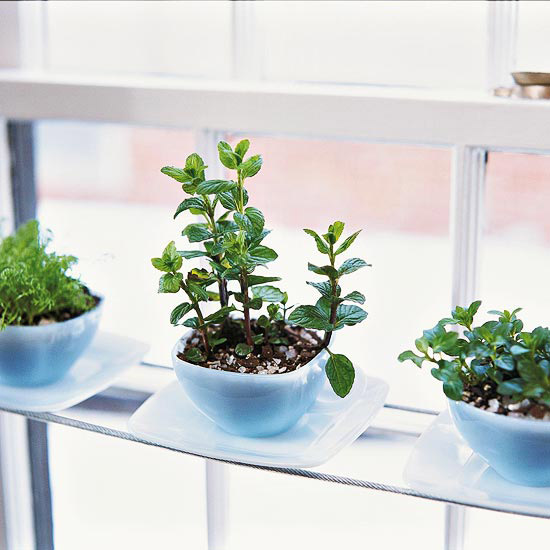
Start a windowsill garden by taking cuttings from some of your favorite indoor and outdoor plants and rooting them in water. Use pruners or a sharp knife to cut a 3- or 4-inch stem; strip off the bottom leaves and place the cut stem in a small container of water. If you like, choose colorful containers and set them on a windowsill for a pretty effect.
Although it doesn't suit every plant, rooting plants in water is the easiest propagation method. Change the water in the containers weekly because stale water turns cloudy and detracts from the attractiveness of the arrangement. More importantly, bacteria may develop and create an unhealthy medium for the plants.
Enjoy the cuttings during the winter months, then transplant them into containers and set them outdoors for the summer.
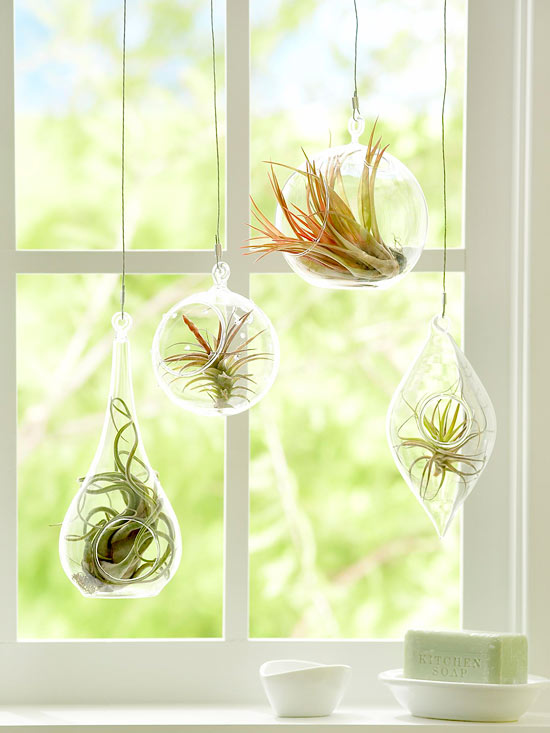
Learn more about growing air plants.
Most plants thrive only a limited time without soil in which to spread their roots. When you transplant rooted cuttings into potting mix, remember that the roots they form in water are finer and more fragile than the ones they develop in soil. For at least a week after transplanting, keep the potting mix moist to avoid shocking the plants and to allow new roots a chance to grow. However, cuttings that are rooted in soil should be watered once when they're placed in a pot of soil to begin developing, and not again until the soil is almost dry.
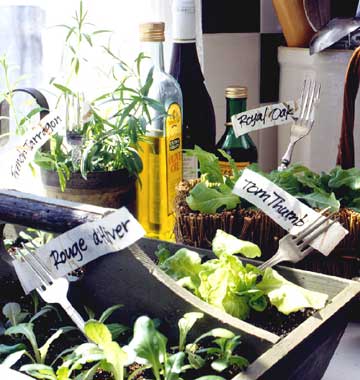
Few traditional outdoor plants are as easy to grow indoors as herbs. Raise them from cuttings or seeds. Place the plants in your sunniest window (preferably one facing south or east, where trees and buildings don't obstruct the light).
A kitchen windowsill keeps the herbs within easy reach when cooking, and pots of herbs make great centerpieces in the dining room on a temporary basis. Some herbs, such as various mints, tarragon, and thyme, grow well in hanging planters. Mints tend to produce smaller leaves when you grow them indoors, but they are just as flavorful. Tarragon succeeds best if you make root divisions or take stem cuttings instead of digging up the whole plant from the garden and attempting to move it indoors.
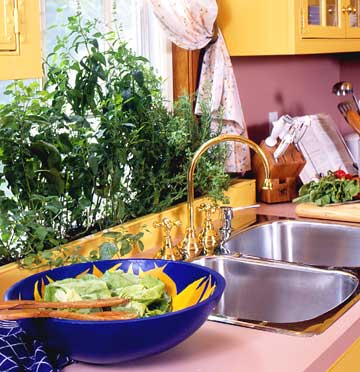
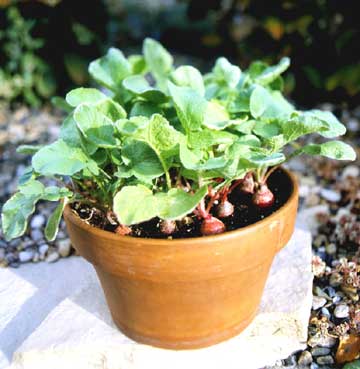
You need a few sunny windowsills or supplemental lighting to grow vegetables, which require at least six hours of direct sun daily. Plant dwarf or patio varieties of vegetables in pots, window boxes, or improvised containers. Hanging baskets make suitable homes for tomatoes, beans, cucumbers, lettuce, and radishes. Train pole beans up tepees or trellises that you make with bamboo poles, or string monofilament from a windowsill planter to the top of the window frame and guide the stems into a living curtain.
Make decorative arrangements by combining different crops in one container. Plant red- and green-leaf lettuce together, for example, or edge a container holding a patio tomato with leaf lettuce and radishes.
Fertilize vegetables every two weeks. Water to keep the soil evenly moist, especially when plants begin to flower and produce fruit. Help fruit production by lightly brushing plants with your hand to spread pollen as they bloom.
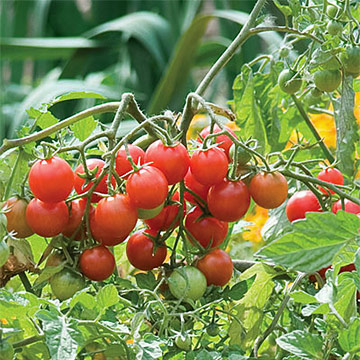
Indoor vegetables often have less flavor than those you grow outdoors, but they definitely have more than most of what you buy at the store.
These vegetables can be grown inside:
Bush beans, bush tomatoes, carrots, cherry tomatoes, cucumbers, loose-leaf lettuce, patio tomatoes, peas, pole beans, radishes, scallions, and spinach.
This decorative planting looks as good on a mantel or side table as it does on a windowsill. Change the accessories to suit a particular holiday or season. Make it easy to change the plantings by leaving plants in their nursery pots instead of planting them in soil when placing them in the window box. Use clumps of moss to camouflage the pot rims. If desired, move the planter outdoors to continue growing through summer. Set it in light shade and keep it watered.
Light: Medium-High Time: 1-2 hours Skill: Easy
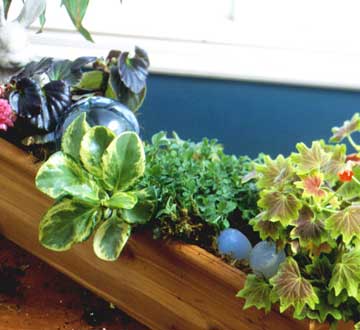
Plants We Used: geranium, oregano, peperomia, begonia, blue ginger
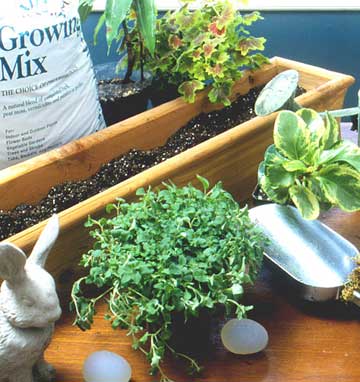
1. Plan: Gather all the plants and soil. Fill the window box partway with soil; before you plant, set the potted plants on top, rearranging until you like the design. Consider plant heights, growth habits, and leaf textures as well as the colors of the blooms. Figure in space for ornaments and statuary. If you plan to use a stone bunny or other animal, give it the shade of a "tree" by placing it under a taller plant.
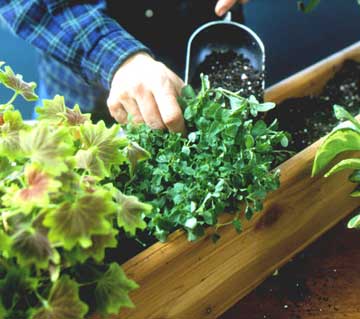
2. Plant: Unpot each plant as you proceed. If the roots of a plant are growing around the outside of its soil ball, gently pry some of them outward and pull others away from the bottom of the root ball. If you omit this, the roots will continue to encircle the root ball instead of moving out into the new soil. Set each plant in the soil and fill around its roots with more potting mix so the plant is at the depth it was growing in the nursery pot. Firm the soil around the plants.
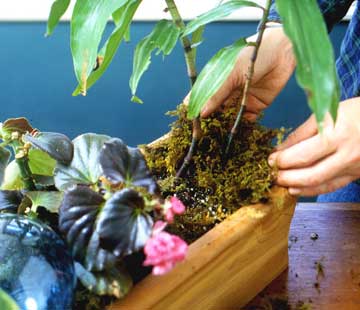
3. Finish: Cover any bare, exposed soil with pieces of sphagnum moss or green moss, tucking them around the stems. Water the planting thoroughly.
Set ornaments, such as glass balls, on top of the moss, nestled among the plants. Use statuary sparingly and in an appropriate size for the small space. One statue should suffice, unless you omit the other ornaments. Place the box in a window with some direct sun or, temporarily, on a mantel in dim light.
Copyright © www.100flowers.win Botanic Garden All Rights Reserved